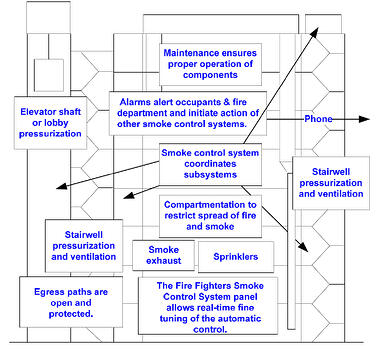Smoke Control Balanced Strategy
Good fire and smoke protection and life safety practices involve use of any and all the different tactics that have been developed. The strategy is the overall plan and the tactics are the components of the mechanical systems. One could say the fire alarm, sprinkler flow switches, and smoke control programming logic are primarily strategic and the sprinkler heads, ducts, fans, and dampers are the tactical methods. In actual practice the two blur together. The Fire Fighters Smoke Control System (FSCS) panel is the interface between strategy and tactics. Figure 1 shows the ideas that are more strategic than tactical.
The strategy coordinates the various components in the system. For example, when the fire alarm is activated, the stairwell pressurization system is automatically turned on so that occupants can exit without being exposed to toxic smoke.
The strategy is based on a number of overriding concepts and the codes prescribe certain practices in most buildings. The mix of tactics is a function of the prescriptions in the code and the fire protection engineers’ design.
Fire alarms alert occupants to danger and the likelihood that they need to exit. External alarms bring fire department assistance. Annunciation may be used to give directions to occupants, particularly in buildings with large footprints and in high-rise buildings.
Emergency planning and fire drills are expected in many buildings although occupation by the general public diminishes the effect of plans.
Egress paths from burning buildings allow escape and provide entrance ways for fire fighters. Exit lights & signs, corridor & stairwell smoke control, and elevator pressurization or lobbies protected by smoke barriers are all important in egress.

Codes are not always clear about the primary function of smoke control. Life safety is the first purpose. Protection of the building and furnishings from smoke damage is of secondary importance. However, it is important to note that protecting property, particularly from collapse, protects occupants and fire fighters who may be in the building after occupants have exited.
Learn more – Download white paper: Actuated Dampers in Smoke Control Systems.

